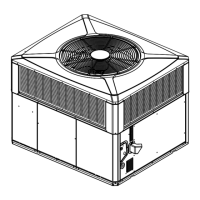30
18-BG07D1-1B-EN
Maintenance
Owner Maintenance
WWAARRNNIINNGG
EEXXPPLLOOSSIIOONN HHAAZZAARRDD!!!!
TToo pprreevveenntt aann eexxpplloossiioonn oorr ppoossssiibbllee iinnjjuurryy,, ddeeaatthh,,
aanndd eeqquuiippmmeenntt ddaammaaggee.. DDoo nnoott ssttoorree ccoommbbuussttiibbllee
mmaatteerriiaallss,, ggaassoolliinnee,, oorr ootthheerr ffllaammmmaabbllee vvaappoorrss oorr
lliiqquuiiddss nneeaarr tthhee uunniitt..
Some of the periodic maintenance functions of the
packaged unit can be performed by the owner; this
includes replacing the disposable or cleaning the
permanent air filters, cleaning the unit cabinet, and
conducting a general unit inspection on a regular basis.
FFiilltteerrss
WWhheenn tthhee ssyysstteemm iiss iinn ccoonnssttaanntt ooppeerraattiioonn, inspect
the filters at least once each month.
If you have disposable-type filters, replace them with
new filters of the same type and size. DDoo nnoott aatttteemmpptt
ttoo cclleeaann ddiissppoossaabbllee ffiilltteerrss..
Permanent-type filters can be cleaned by washing them
with a mild detergent and water. Make sure that the
filters are thoroughly dry before reinstalling them.
NNoottee:: It may be necessary to replace permanent filters
annually if washing fails to clean the filter or if
the filter shows signs of deterioration. Be sure to
use the same type and size as was originally
installed.
CCoonnddeennsseerr CCooiill
Be sure to keep all vegetation and debris away from the
condenser coil area.
Service Maintenance
Service maintenance should be performed by qualified
service personnel.
CCoooolliinngg SSeeaassoonn
To keep the unit operating safely and efficiently, the
manufacturer recommends that a qualified service
technician check the entire system at least once each
year or more often if needed. The service technician
should examine these areas of the unit:
• filters (for cleaning or replacement)
• motors and drive system components
• economizer gaskets (for possible replacement)
• safety controls (for mechanical cleaning)
• electrical components and wiring (for possible
replacement and connection tightness)
• condensate drain (for proper sealing and cleaning)
• unit duct connections (to see that they are
physically sound and sealed to the unit casing)
• unit mounting support (for structural integrity)
• the unit (for obvious unit deterioration)
HHeeaattiinngg SSeeaassoonn
Complete the following unit inspections and service
routines described at the beginning of each heating
season.
• Visually inspect the unit to ensure that the airflow
required for combustion and condenser coil is not
obstructed from the unit.
• Inspect the control panel wiring to verify that all
electrical connections are tight and that the wire
insulation is intact.
• Check the operation of the gas ignition system as
follows: Turn off the gas supply with the unit
operating to verify that the gas valve closes and
that a re-ignition cycle is initiated by the unit.
• Visually inspect the inside of the burners and the
burner ports for deposit buildup and corrosion.
Wipe and brush the inside of the burner and the
burner ports and then clean with a dry cloth. If the
deposit buildup or corrosion is excessive, replace
the burners.
Flue Cleaning
NNoottee:: Never use combustible cleaning fluids on any
part of the furnace.
Before each heating season, the flue should be
inspected for signs of flaking rust and soot deposits.
DDiirrttyy fflluueess sshhoouulldd bbee cclleeaanneedd bbyy qquuaalliiffiieedd sseerrvviiccee
ppeerrssoonnnneell OONNLLYY using the following procedure:
1. Turn the comfort control to OOFFFF. Turn the main
power disconnect OOFFFF. Turn the manual gas valve
OOFFFF.
2. Remove the flue hood and the CONTROL/HEAT
access panel.
3. Remove the combustion blower assembly from the
flue box. Remove the flue box and the flue
restrictors.
4. Remove all wires from the gas valve while carefully
noting their locations.
5. Disconnect the gas supply line from the valve.
6. Remove the manifold retaining screws and pull the
burner-manifold assembly from the heat
exchanger.
7. Remove the inlet turbulators being careful not to
break or damage them.
8. Wipe the flue box and flue baffles clean with a
clean, dry cloth.
9. Never use combustible cleaning fluids on any part
of the furnace.
10. Replace all gaskets with new ones.
11. Replace all damaged or broken turbulators with
new ones.
12. Reassemble the unit by reversing Steps 2 through 7
above. Take care that all gaskets seat properly.
UUnniitt SSttaarrttuupp

